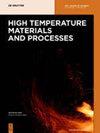等离子弧焊接铬镍铁合金617板微观结构和力学性能的实验研究
IF 1.5
4区 材料科学
Q4 MATERIALS SCIENCE, MULTIDISCIPLINARY
引用次数: 0
摘要
摘要铬镍铁合金的焊接是一项艰巨的任务,因为它容易开裂,对焊工来说也很复杂。然而,它被广泛用于需要在高温下抗氧化的应用中。因此,需要注意的是,铬镍铁合金的焊接要求很高。在这种情况下,必须使铬镍铁合金617的焊接自动化,以消除一些工艺不确定性。等离子弧焊(PAW)是一种高度非线性的工艺,可以很容易地实现自动化,并且可以提供更集中的电弧来焊接高强度和抗蠕变的合金。在本研究中,PAW工艺用于2 mm厚的铬镍铁合金617板,通过改变焊接电流和焊接速度等关键工艺参数。最初,进行了板上焊道(BoP)实验,以确定焊接超级合金的合适焊接参数范围。随后,基于BoP焊接的结果进行板的对接焊接。此外,还进行了一项研究,以确定焊接工艺参数对对接接头微观结构和力学性能的影响。本文章由计算机程序翻译,如有差异,请以英文原文为准。
Experimental investigation on microstructural characterization and mechanical properties of plasma arc welded Inconel 617 plates
Abstract Welding of Inconel is a difficult task due to its tendency to crack and posing intricacies to the welder. However, it is extensively used in applications where resistance to oxidation at elevated temperatures is required. Therefore, it is important to note that the welding of Inconel alloys is demanding. Under such circumstances, one has to automate the welding of Inconel 617 alloy to eliminate some of the process uncertainties. Plasma arc welding (PAW) is a highly non-linear process that can be automated easily, and it can provide more focussed arc to weld the high strength and creep-resistant alloys. In the present research, PAW process is employed on 2 mm thick Inconel 617 plates by varying the key process parameters, such as welding current and welding speed. Initially, bead on plate (BoP) experiments were conducted to determine the suitable range of welding parameters to weld the super alloy. Subsequently, butt welding of the plates was performed based on the results of BoP welding. Furthermore, a study was conducted to determine the influence of the welding process parameters on the microstructural and mechanical properties of the butt joints.
求助全文
通过发布文献求助,成功后即可免费获取论文全文。
去求助
来源期刊

High Temperature Materials and Processes
工程技术-材料科学:综合
CiteScore
2.50
自引率
0.00%
发文量
42
审稿时长
3.9 months
期刊介绍:
High Temperature Materials and Processes offers an international publication forum for new ideas, insights and results related to high-temperature materials and processes in science and technology. The journal publishes original research papers and short communications addressing topics at the forefront of high-temperature materials research including processing of various materials at high temperatures. Occasionally, reviews of a specific topic are included. The journal also publishes special issues featuring ongoing research programs as well as symposia of high-temperature materials and processes, and other related research activities.
Emphasis is placed on the multi-disciplinary nature of high-temperature materials and processes for various materials in a variety of states. Such a nature of the journal will help readers who wish to become acquainted with related subjects by obtaining information of various aspects of high-temperature materials research. The increasing spread of information on these subjects will also help to shed light on relevant topics of high-temperature materials and processes outside of readers’ own core specialties.
 求助内容:
求助内容: 应助结果提醒方式:
应助结果提醒方式:


